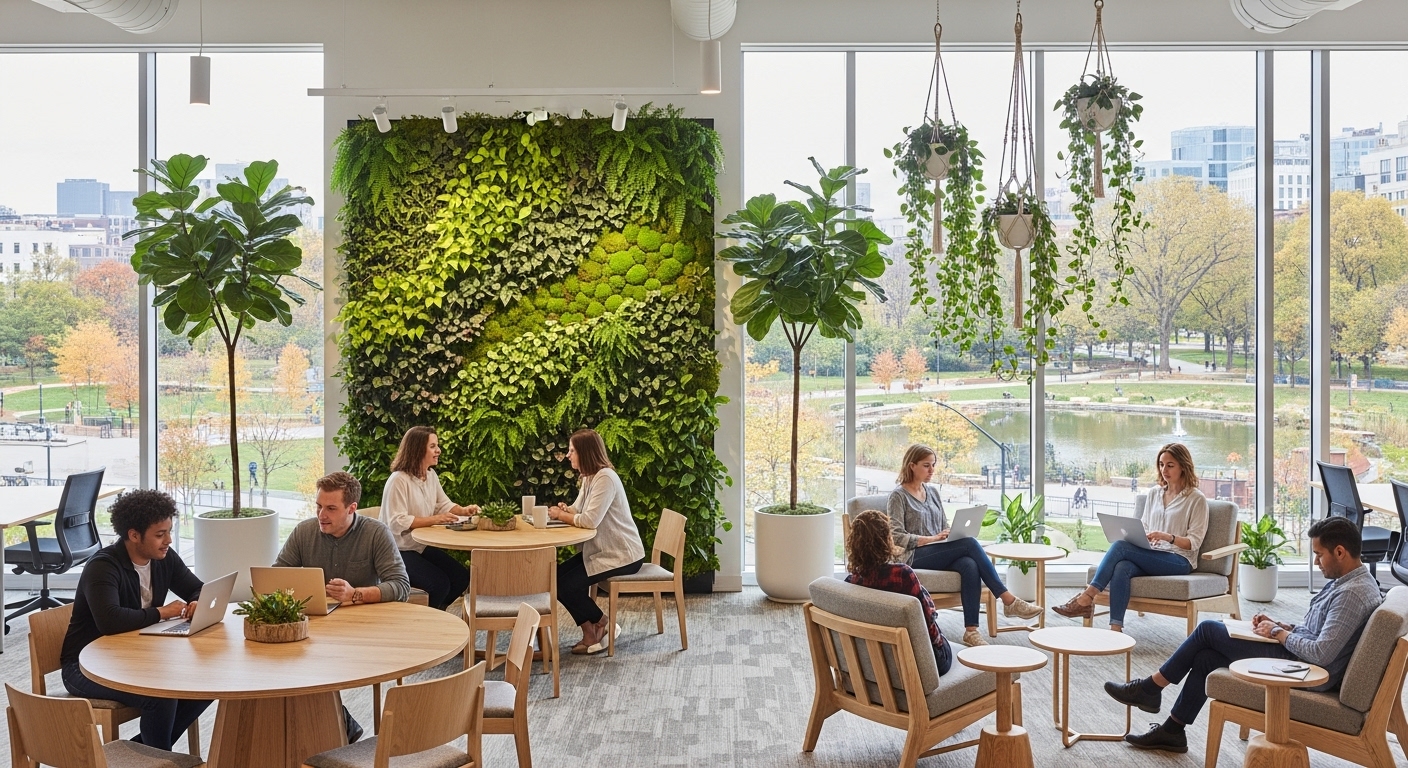In today’s competitive landscape, the conversation around office environments has evolved far beyond ergonomics and aesthetics. A new imperative has emerged, driven by climate consciousness and a changing workforce: sustainability. Yet, the concept itself is transforming. It’s no longer enough to simply reduce a building’s negative impact. The future of work demands a ‘net-positive’ approach—creating workspaces that actively give back to the environment, enhance human well-being, and drive profitability. This holistic model moves beyond simple recycling programs and energy-efficient lightbulbs, framing sustainability as a core strategic driver. It recognizes that the health of the planet is inextricably linked to the health of its people and the resilience of its economy. This article explores the integrated framework of a net-positive workplace, a model where every decision, from material selection to air quality management, is designed to create a positive return for the planet, its inhabitants, and the bottom line. We will delve into how this paradigm shift is reshaping office design, attracting top-tier talent, and ultimately defining the most successful businesses of tomorrow.
From LEED to Leadership: Redefining Sustainability Beyond Certification
For years, certifications like LEED (Leadership in Energy and Environmental Design) and WELL have been the gold standard for sustainable architecture. They provided a crucial framework for measuring energy consumption, water usage, and indoor environmental quality, pushing the industry toward a more responsible model. However, in the context of the net-positive workplace, these certifications are not the finish line; they are the starting block. True leadership today means moving beyond the checklist of compliance to a more profound philosophy of regeneration and contribution. The focus is shifting from a ‘do less harm’ mindset to a ‘do more good’ strategy. This involves not just minimizing a building’s carbon footprint, but striving to make it carbon-negative, or creating landscapes that enhance local biodiversity rather than merely occupying space. The triple bottom line—People, Planet, and Profit—serves as the guiding principle for this advanced approach. Instead of viewing these three pillars as separate objectives that require trade-offs, the net-positive model sees them as interconnected parts of a single, synergistic system. A decision that benefits the planet, such as installing superior air filtration systems, directly benefits people by improving cognitive function and reducing illness. This, in turn, benefits profit through increased productivity and lower absenteeism. This integrated thinking requires a fundamental shift. It challenges leaders to ask more ambitious questions: How can our office actively clean the air? How can our landscaping support local pollinators? How can our waste streams become a source of revenue or resources for our community? By reframing the goal from mitigation to positive impact, companies position themselves not just as responsible corporate citizens, but as innovative leaders shaping a resilient and thriving future.
The Biophilic Bonus: Designing for Human Health and Productivity
At the core of the ‘People’ pillar within the net-positive framework is biophilic design—an architectural approach that connects building occupants more closely to nature. This concept extends far beyond placing a few potted plants on desks. It is a comprehensive design discipline that thoughtfully incorporates natural light, living green walls, organic materials like wood and stone, and even forms and patterns that mimic those found in the natural world. The benefits of this approach are profound and well-documented. Extensive research has demonstrated that environments rich in biophilic elements can significantly reduce stress, lower blood pressure, and improve mental clarity. One frequently cited study found that office workers with views of nature took 19% fewer sick days than those without. The ‘Biophilic Bonus’ is the tangible return on this investment in human-centric design. Natural light, for example, helps regulate circadian rhythms, leading to better sleep and higher energy levels during the day. Exposure to natural elements has been shown to boost creativity and problem-solving skills, which are critical for an innovative workforce. This isn’t just about feeling good; it’s about performing better. A workspace that intentionally integrates these features becomes an active tool for enhancing employee well-being and, by extension, their productivity. In a net-positive workplace, every window, every material choice, and every layout decision is evaluated for its potential to foster a deeper connection to nature, creating a restorative environment that helps employees feel energized, focused, and valued.
The Circular Economy at Work: From Waste Streams to Value Streams
The traditional office model operates on a linear ‘take-make-dispose’ system. Resources are procured, used, and ultimately sent to a landfill. The net-positive workplace shatters this model by embracing the principles of a circular economy, a system designed to eliminate waste and promote the continual use of resources. This is a fundamental reimagining of a company’s material lifecycle, turning what was once a ‘waste stream’ into a ‘value stream.’ In practice, this starts with procurement. Furniture is selected not just for its aesthetic or cost, but for its entire lifecycle. Companies prioritize modular furniture that can be easily repaired, reconfigured, or disassembled for recycling. They partner with suppliers who offer take-back programs or use certified recycled content. This philosophy extends to every corner of the office. Single-use plastics are eliminated from break rooms, replaced with durable, reusable alternatives. Comprehensive composting programs divert all organic waste from landfill. Beyond internal operations, a circular approach involves looking for synergies within the broader community. Could waste heat from an on-site data center be used to warm a neighboring building? Can used coffee grounds be donated to a local community garden for fertilizer? This approach offers powerful benefits for both planet and profit. It dramatically reduces environmental impact by conserving resources and cutting carbon emissions associated with manufacturing and waste disposal. Financially, it lowers costs through reduced purchasing needs and waste hauling fees. By designing waste out of the system from the beginning, a circular office becomes a model of efficiency and resourcefulness, proving that what is good for the planet is also good for the business’s financial health.
Smart Tech, Smarter Spaces: The Role of IoT in a Net-Positive Building
Technology is the nervous system of the modern sustainable workspace, enabling a level of efficiency and responsiveness that was previously impossible. The Internet of Things (IoT) is at the forefront of this transformation, embedding intelligence directly into the building’s infrastructure to optimize resource use and enhance the human experience. Smart sensors are the workhorses of this system. Occupancy sensors, for instance, provide real-time data on how spaces are being used, allowing HVAC and lighting systems to power down in empty rooms automatically, drastically cutting energy waste. This goes beyond simple motion detectors; sophisticated systems can analyze usage patterns over time, helping facility managers optimize layouts for better space utilization. Air quality is another critical area where tech plays a pivotal role. IoT sensors continuously monitor levels of carbon dioxide (CO2), volatile organic compounds (VOCs), and particulates. When CO2 levels rise in a crowded meeting room, indicating stale air that can impair cognitive function, the system automatically increases ventilation. This creates a healthier and more productive environment, directly linking the building’s performance to the well-being and output of its occupants. Smart water management systems detect leaks the moment they occur, preventing waste and costly water damage. Even windows can be automated to optimize natural light and thermal comfort. This data-driven approach allows a building to be managed with surgical precision, ensuring that resources are consumed only when and where they are needed. By leveraging smart technology, a net-positive workplace becomes a dynamic, living ecosystem that actively works to conserve resources while creating the optimal conditions for its inhabitants to thrive.
The ROI of Resilience: Calculating the Financial Benefits of Going Green
For any business, strategic initiatives must be justified by a clear return on investment (ROI), and sustainability is no exception. The financial case for a net-positive workplace is multifaceted and compelling, extending far beyond lower utility bills. While energy and water savings provide a direct and easily measurable benefit, the true financial upside lies in the secondary, yet more impactful, returns. Enhanced employee productivity is a significant factor. As studies on biophilic design and air quality show, a healthier work environment leads to more focused, creative, and efficient employees. A modest 1% increase in productivity across a large workforce can translate into millions of dollars in value. Similarly, reducing employee turnover is a powerful financial lever. The cost to replace an employee—including recruitment, hiring, and training—can range from 50% to 200% of their annual salary. By creating a desirable, healthy, and mission-aligned workplace, companies can significantly improve retention rates, yielding substantial savings. Furthermore, properties with strong sustainability credentials, such as LEED or WELL certifications, often command higher rental rates and property values. They are also more attractive to a growing class of institutional investors focused on Environmental, Social, and Governance (ESG) criteria. Strong ESG performance can lead to a lower cost of capital and better access to investment. Finally, building for resilience—using durable materials, managing resources efficiently, and fostering a healthy workforce—makes a business less vulnerable to supply chain disruptions, resource price volatility, and public health crises. The ROI of sustainability is not just a line item on a budget; it is an investment in long-term business resilience and profitability.
The Talent Magnet: Why the Future Workforce Demands Sustainable Employers
In the competitive war for talent, a company’s physical workspace has become a powerful tool for differentiation. For Millennial and Gen Z workers, who will soon constitute the majority of the workforce, a company’s values are just as important as its salary and benefits packages. A demonstrable commitment to environmental and social responsibility is no longer a ‘nice-to-have’—it is a core expectation. A net-positive workplace serves as the most tangible and visible proof of this commitment. It is a daily, physical manifestation of a company’s values in action. When a potential hire walks into an office filled with natural light, living walls, and clear evidence of a circular economy, it sends a powerful message that the organization cares about the well-being of its employees and the planet. This can be a deciding factor for top candidates choosing between multiple offers. As one Glassdoor survey found, 75% of employees expect their employer to be environmentally responsible. This sentiment is not just about idealism; it’s about a desire for purpose and alignment. People want to work for organizations that are part of the solution, not the problem. A sustainable office fosters a sense of pride and shared purpose among employees, which can boost morale and engagement. It becomes a story that employees are proud to tell, turning them into brand ambassadors. In this sense, the investment in a net-positive workplace is also an investment in marketing and employer branding, creating a magnetic pull that attracts and retains the very people who will drive the company’s future success.
Conclusion: Building Tomorrow’s Business Today
The transition to a net-positive workplace represents a pivotal evolution in corporate strategy. It marks the moment we move beyond viewing sustainability as a cost center or a compliance checkbox and begin leveraging it as a powerful engine for growth, innovation, and resilience. By intentionally integrating the needs of the planet, the well-being of people, and the demands of profit, businesses can unlock a virtuous cycle. A healthier environment fosters a more productive and engaged workforce. An efficient, circular operation reduces costs and mitigates risk. A clear commitment to positive impact attracts top talent and loyal customers. This is not a futuristic ideal; it is a practical and achievable goal that is being realized by forward-thinking companies around the world. The journey requires a shift in mindset—from linear to circular, from depletion to regeneration, and from isolated metrics to an integrated system. The leaders who embrace this holistic approach will not only be building better offices; they will be building stronger, more adaptable, and more valuable businesses. The net-positive workplace is more than just a building; it is a blueprint for a future where commercial success and collective well-being are one and the same. It is the foundation upon which the most resilient and respected organizations of tomorrow will be built.





